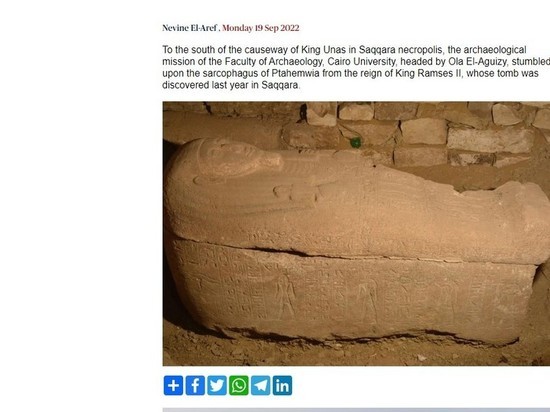The sarcophagus of the head of the treasury of King Ramses II discovered in Egypt – the mummy has disappeared
[ad_1]

In Egypt, south of the dam of King Unas in the necropolis of Saqqara, employees of the Faculty of Archeology of Cairo University, led by Ola El-Aguizi, stumbled upon the sarcophagus of Ptahemvia dating from the reign of King Ramses II, whose tomb was discovered last year in Saqqara.
Mostafa Waziri, general secretary of the Supreme Council of Antiquities, said that Ptahemvia has several titles, including royal scribe, grand overseer of cattle at the Temple of Ramses II, head of the treasury and in charge of offerings to all the gods of Lower and Upper Egypt.
The entrance to the tomb shaft in the center of the peristyle courtyard measured 2.2 x 2.1 m. The underground burial chamber was unearthed on the western side of the shaft at a depth of 7 m. other rooms on the west and south sides. These two rooms were completely empty. In the main room, he added, a cut was seen in the floor on the north side, leading to a staircase leading to the actual burial chamber measuring 4.6 x 3.7 m.
The sarcophagus was found in the western part of the burial chamber. It was located from south to north. The lid of the sarcophagus was anthropomorphic, showing the facial features of the deceased with crossed arms on his chest, holding the Djed symbol of the deity Osiris and the Tait symbol of the goddess Isis.
The sarcophagus is decorated with the usual inscriptions found on the sarcophagi of the New Kingdom, with the sky goddess Nut sitting on the chest of the deceased with outstretched wings.
On the lid and body of the sarcophagus, the name of Ptahemvia and his titles, images of the four sons of Horus, and prayers are engraved all over the body of the sarcophagus.
“The lid of the sarcophagus was broken diagonally and the missing piece was found in the corner of the chamber. The sarcophagus itself was empty, except for the remains of resin from mummification at the bottom, writes ahram.org.
[ad_2]
Source link








